The goal of the first contact message with your potential customers is to create interest, to get them on phone, or motivate them to try out your product. This can be in the form of your website homepage, cold email outreach, cold phone outreach, or even paid ads on third-party platforms like Facebook, LinkedIn, etc.
In this article, I’ll walk you through the process of how to phrase your core messaging, which you can then reformat to fit the channel – be it website, email, phone, or ads.
Worksheets are available to download later below.
As the founder or founding team member of 13 startups, mostly in B2B SaaS, I speak from experience. We grew from one company to over 200 employees and we just sold Teleport, my last startup.
Over the years, I’ve created first-contact messaging for all kinds of potential customers. While the details differ from startup to startup, the fundamentals remain the same.
Effective market messaging is based on understanding who your customer is, how your product or service helps them, and how your company delivers value.
Your message is shaped by your customer.
Before you even begin to create a message, you need to know who you are creating it for. You might have heard of the buyer persona. But in a B2B startup, a buyer persona isn’t enough – you also need an Ideal Customer Profile (ICP).
ICP is a composite description of an organization (company, government agency or nonprofit) that finds a specific value in your offering and provides excellent value to you in return.
In this context, a buyer persona means the decision maker/s in that organization who’ll decide to buy your product for the company. Remember, they may not be the user of your product – but without their approval, nobody will pay for your product.
For early-stage B2B startups, your initial focus should be on ICP much more than the buyer persona. Generally speaking, it’s easier to understand the need of client companies than the motivations and incentives of individual decision-makers. Not to mention that, in many cases, you’ll need more than one decision-maker to sign off on the deal.
So, in the beginning, you’re better off focusing on ICP. As you grow sales and have high-quality touchpoints with decision-makers across many client companies, you’ll get a clearer understanding of their motives and incentives – at that point, you can fine-tune your messaging to better suit the buyer persona.
In the meantime, your messaging can be focused on client companies, while still using language/words that resonate with decision-makers.
Your ICP is the foundation of all your sales and marketing efforts.
When you start to build your lead generation system, it’s critical to get the foundation right – just like when constructing a house.
If you build on a weak foundation, you’ll later be forced to spend a ton of time, money, and effort re-balancing the walls and roof. Otherwise even a slight wind, blowing at a certain angle, could bring the building down on your head!
A strong ICP helps you maximize sales and marketing productivity by doing two things:
- Find great prospects more easily through smart targeting.
- Disqualifying poor prospects more quickly.
To put it simply, your ICP is a template to define your best customer as of right now. This, in turn, will shape everything else about your company (not just first contact messaging) – from the features and functionality of your product and what makes up your service offering, to the words you use and the emotions you aim to evoke through your marketing.
And that, in turn, will drive your success or your failure. So, it’s crucial to define your ICP as accurately as possible, based on your current knowledge.
Creating your ICP helps you identify the types of accounts that will deliver on the key economics for your company, such as close rate, potential revenue, velocity, and retention. It also forms the basis for your target account list, priority setting, and qualification criteria.
Remember, this isn’t a one-time exercise. You’ll go through many revisions by the time you reach product-market fit for a certain ICP. But it’s definitely worth the time and effort – mastering this concept will help you throughout the lifetime of your company.
Even when you get traction and growth for your current product, you may need to redefine your ICP when you add new features or expand to another market segment or geographical area.
You see, the goal of creating your ICP isn’t just to define one type of customer to focus on forever. It’s to define your ideal customer at a particular time, stage, and situation of your company and product.
Your ideal customer today is someone who can achieve success using your product as it is today.
Think about it like this: if you only got paid after proving to your customer that they’ve achieved success by using your product, who would you work with?
Stop looking for Mr. Right – you’ve got to find Mr. Right Now.
Take the example of Eric Howie, founder of Life Detection Technology, a company that introduced a technology that captures heart and respiration rates without touching the human body. In the beginning, Howie was able to identify 41 industries as potential customer types. But, ultimately, he decided to focus on just one: baby monitoring. Later down the road, he changed the ICP again when the company reached another level in its path of growth.
I’ve noticed that many founders are afraid to narrow down and pick a single ICP. This is largely due to Fear of Missing Out (FOMO) on other potential customers.
But the reality is that if you don’t focus on a specific type, you’ll end up trying to sell everything to everyone. Your sales and marketing will become clouded and vague. It’ll be tough for any customer to see how your offering applies to their particular problem.
In the end, you won’t be able to connect with anyone – including your ideal customers!
Often, people associate the word “niche” with limited vision. Let’s get that misunderstanding out of the way right now.
When you nail down a niche, you’re not “thinking small”. You’re not curbing your dream or permanently shrinking your addressable market.
To find a niche means to find focus, to hone in on a specific target customer with a specific problem – no matter how many other types of customers you could help or how many other kinds of problems you could solve.
Don’t let your larger-than-life vision or big, audacious goal get in the way of taking the baby steps that are necessary for you to get customers today.
Hypergrowth (i.e. maintaining an average annual growth rate of over 40 percent) doesn’t come from selling various things to various markets.
Hypergrowth comes from focusing on where you find the best chances of winning customers, making them successful, and building a reputation for tangible results – and then growing from there.
You don’t have to think hard to come up with success stories for this strategy. Salesforce.com began with sales force automation. Zenefits focused on Californian tech companies with 100-300 employees. Amazon started with books. Facebook focused on Ivy League schools. PayPal began with eBay users. Zappos took off with shoes. And so on….
The core of your message is your Unique Value Proposition (UVP).
Remember – customers don’t buy products, they buy solutions to their problems.
There is an old story told by sales professionals. A man who made mattresses was having trouble selling them. A friend asked him, “What are you selling?”
The mattress maker replied, “Why, mattresses of course.”
His friend shook his head and said, “No, mattresses are what you make. What you sell is a good night’s sleep.”
Your UVP is what you do for your customer. It’s a clear statement of the tangible results a customer gets from using your product or service.
For each of your ICPs, you’ll develop a UVP that describes the value your product delivers, and how that differs from your competition. For example:
- Whole Foods: The groceries may cost a lot, but the value of being healthy outweighs the cost.
- Unbounce: Webpage A/B testing without tech headaches.
- Zappos.com: The world’s largest shoe store delivered to your door with free shipping both ways.
That brings us to a crucial question: How do you define and measure the success your customers receive after using your product?
Success doesn’t just mean that they buy your product with the promise that they’ll get value out of it.
Success means knowing for a fact that if you call a customer and ask them if they’re getting more value from your solution compared with what they’re paying for it, they’ll answer “yes”.
To define success, you need to first understand why someone is buying your product.
Consumers don’t buy what they need; they buy what they want. Just think of how much people spend on sleek cars and sugary drinks compared with broccoli and psychotherapy.
But businesses are a whole other story. They usually buy a product based on four key reasons: it makes them money, it saves them money, it gives them a competitive edge (if they aren’t already market leaders), or it helps them stay compliant (and therefore avoid fines and legal risk, keep management out of jail, etc.).
In other words, businesses don’t buy “nice to have” products. For example, a business may want a beautiful website, but what they need is a website that converts visitors to outcomes such as leads or purchases – and the latter is what they’ll ultimately spend their money on.
CEOs might want happy employees – but what they need is for people to show up and do their jobs, products to be released on time and cash flow to be improved.
Venture capitalists may want to invest in honorable founders – but they need to generate above-average returns, which may or may not come from companies with honorable founders.
You get the idea, right?
So, you have to focus on delivering something that businesses really need. But the way you describe it can’t be too generic. If you simply promise to “increase revenue” or “decrease costs”, you’ll sound just like everyone else.
Instead, you need to figure out what is equivalent to money or competitive advantage in their minds. Leads? Close rates? Social activity? Collections? Employee engagement or fulfillment?
For example, while everyone agrees that satisfied employees are important, how can they actually help a business make more money? How will better employee relations or better resources/tools improve profitability? How can you prove that your product is needed to do this?
(One exception to this rule is that in an enterprise environment, you may be able to sell your product if it helps the decision maker to protect himself against criticism or repercussions in front of his boss.)
Based on the above, it’s important for you to define and measure the success of your product in terms closest to these four reasons:
- Make more money
- Save more money
- Gain a competitive advantage
- Compliance (keeping management out of jail)
The definition and measure of the success created by using your product is your UVP. This also helps you to create an effective elevator pitch.
For example: “We help independent doctors [ICP] reduce income tax payment by 10 percent per year [UVP] by using XYZ [solution].”
Here’s another example of UVP, which highlights why the solution is valuable for potential clients and includes an example of past success: “We assist large businesses to reduce spending on their benefits programs, without affecting the level of services. As healthcare costs continue to skyrocket, this is a major concern for many companies. A recent client, a big manufacturer like you, was struggling to cut costs in this area. With our help, they were able to save US$ 500,000 within just four months. And the employee benefits remained unaffected.”
Another example: “I assist tech companies that are in the process of introducing a new product into the market. In such a scenario, it’s imperative for the product to be successful so that the company can meet its sales forecast. I help out in the hand-off between marketing and sales, an area that is often overlooked and dropped. The result: my clients are able to achieve their sales goals and reduce time to profitability.”
Pro tip: If possible, put a number to the benefit offered by your solution. If you can say that past clients have saved 10 hours a week by implementing your solution, that’s far more compelling than simply saying they saved a lot of time.
I understand that in the early stages you don’t have enough data from previous customers to justify such a quantified outcome. In that case, make something up! Yes, I really mean it – it doesn’t have to be accurate, just logical. Do you really think your customer cares if you say you can potentially save them 10 hours per week – but they actually save only 8?
What quantitative value you can reasonably offer? If you’re thinking – well, it depends on the client’s needs and situation – then chances are you need to consider niching down at this point in your startup. You can always expand your market later.
Unique Value Proposition (UVP) vs. Unique Selling Proposition (USP)
USP is what your product does, and UVP is what it does for someone. A quarter-inch drill bit drills quarter-inch holes – that’s the USP. It allows me to make my kids happy by hanging a picture on the wall – that’s the UVP.
As explained in the previous section, your UVP is a clear statement of the tangible results your customer gets by using your product.
Your USP, on the other hand, is what your product does and how it’s different from your competitor’s offerings. It’s a promise of the quality that will be delivered and the value the customer will experience.
Here’s another way to differentiate between the two concepts: Think of USP as features, and UVP as the benefits of those features.
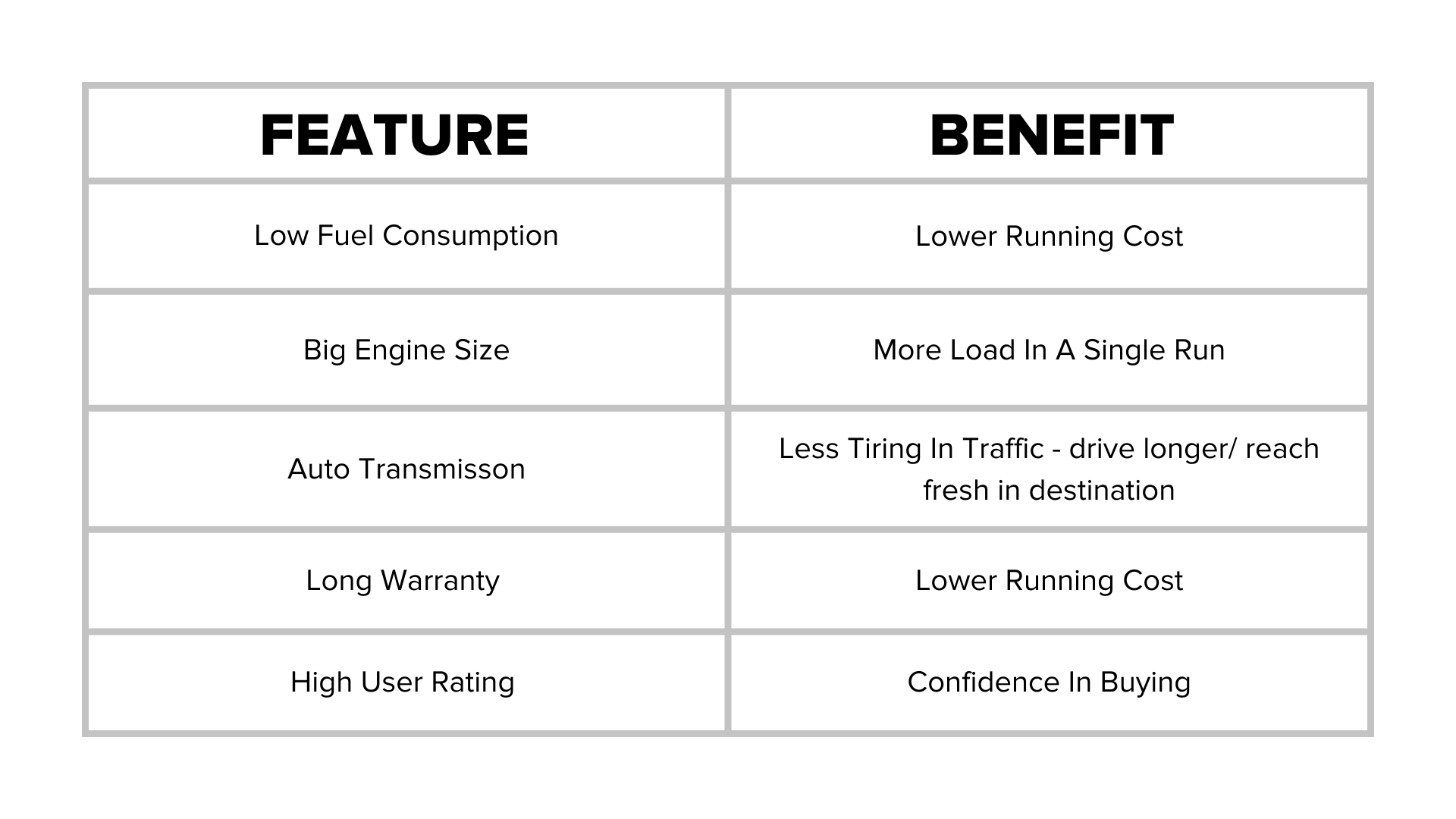
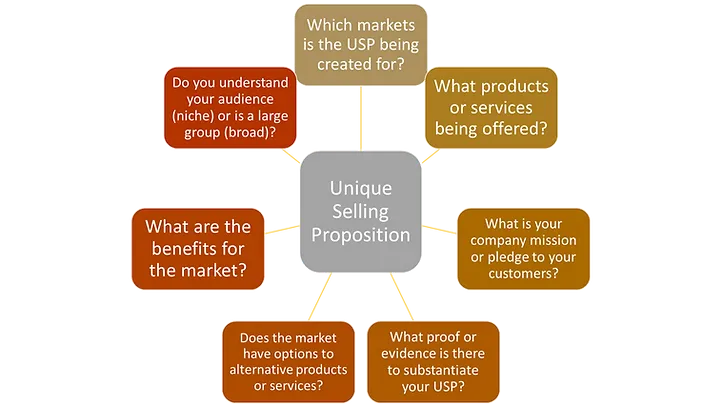
Your USP could include:
- Specialization. For E.g. we specialize in working with financial institutions.
- Guarantee. E.g. we guarantee service within six hours or your money back.
- Methodology. E.g. we use a unique tool called XYZ to analyze your critical needs.
A step-by-step guide to creating your first contact messaging.
Now that you’re clear on all the key concepts, here’s a step-by-step guide on how to find your ICP, UVP, and USP.
Step 1 – Find and replicate your best customers.
If you already have existing customers that are happy with your solution, the best way to achieve rapid growth is to find other customers who are exactly like them.
Maybe there are only 500 companies in the world that are exactly like your existing best customers. That’s great – why not first grow your company with these 500 customers and only then expand to other types?
Get all the low-hanging fruits before you try to reach higher branches.
Begin by going through all your previous and existing customers. List down all those who you think have definitely achieved success using your product.
Fill out the account review template (provided after the set of questions below) in as much detail as possible – the more information you have, the better you can build your ICP later on.
By this point in your startup, you should be able to answer these questions:
- Who are your past and existing customers? What do they use your product for?
- Which industry(ies) do they belong to?
- Where are they located?
- What is their size in terms of employees and revenue?
- What is the deal size for each customer? What is the average deal size?
- Are they a one-time or recurring (active) payment customer?
- In the case of one-time payment customers, do they keep coming back to buy more?
- When was each customer acquired? How long have they been using your product?
- What is the current status? Why did they churn (if applicable)?
- Who are the decision-makers? Who are the influencers? Is there more than one decision maker in the sales process? Who are they?
- Is there a specific reason the customer bought from you?
- How, how much, and how often are customers currently using your product?
- How many market segments do you have?
- How many customers do you have in each segment?
- Does each segment have the same use case? Why or why not?
- What is the most common use case for your product? What features are they using and why?
- Can you identify any trends across your current accounts and customers?
- What is your hypothesis for classifying a good customer vs. a bad customer?
You can use the account review template below (or any tool that supports such functionalities) to map your existing customer profiles.


Step 2 – Create the first draft of your ICP.
Create an initial hypothesis of what’s common among these customers – i.e. those who have definitely achieved success using your product – and what sets them apart from other customers. This is the first draft of your ICP.
Focus on what’s distinctive about this group. What gives them a clear understanding of the problem you’re solving? What enables them to achieve success quickly and effectively using your product?
You may end up with several hypotheses. That’s okay. We’ll prioritize and validate these in the next few steps.


Also, there might be certain exceptions to your ICP profile. List down any red flags and deal breakers. For example:
- They just installed a _______ kind of system.
- They already have an agency/service provider in place or a full-time in-house person dedicated to _______.
- They are located in _______.
- Their monthly budget for _______ is only _______.
- These industries never seem to work: _______, _______, _______.
- This area of work is totally new to them, and they don’t understand it yet. (I.e. you would have to educate the client a lot for them to even understand the value of your service.)
Step 3 – Prioritize your ICPs.
Okay, now it’s time to prioritize your ICPs. You can do this based on a few metrics:
- Can they achieve success by using your product in its current state?
- How quickly can they see success?
- How long would it take you to reach decision-makers?
- How long is their buying cycle?
- How many of them are out there?
Put the answers in the following Excel file and multiply the numbers. Organize your priority from the highest number to the lowest.
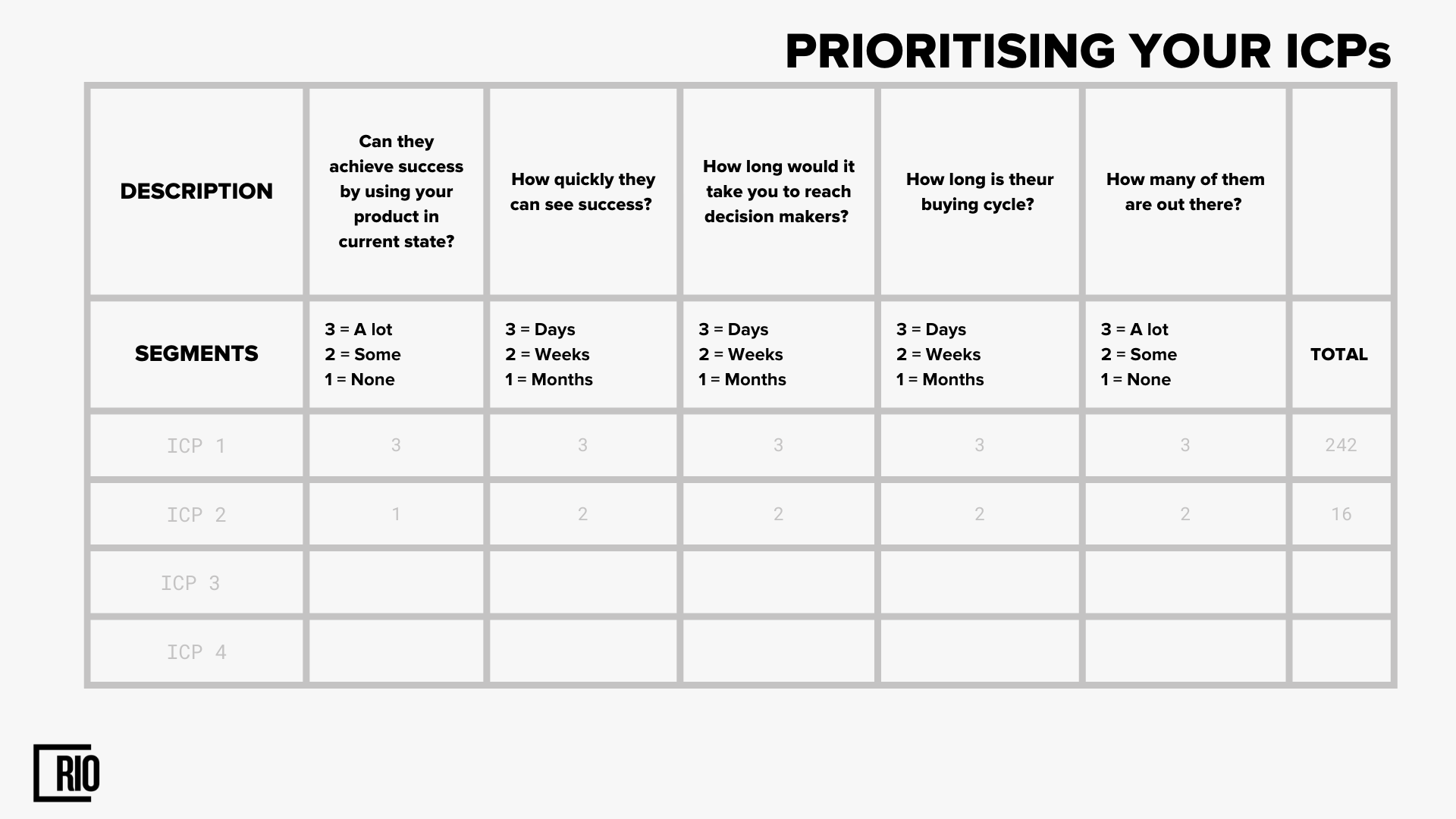
Step 4 – Discover how customers see your product.
Validate your true ICP by interviewing your existing customers. These conversations will also help you discover in detail how customers see your product’s USP and UVP – down to the exact words they use to describe the solution and its success.
Before the interview, conduct a deep dive into the clients and their usage of your product.
- Study the data you already have about how they’re using your product.
- Create a hypothesis of their problem.
- Create a hypothesis of what success might look like to your customer.
Study all the data you can acquire about:
- how,
- how much,
- how often and
- who in the company is using your product.
- What are they measuring, and does it give any indication of how much success they are achieving using your product?
At the interview, you’ll need to ask some key questions. Check out the prep document I’ve provided below.
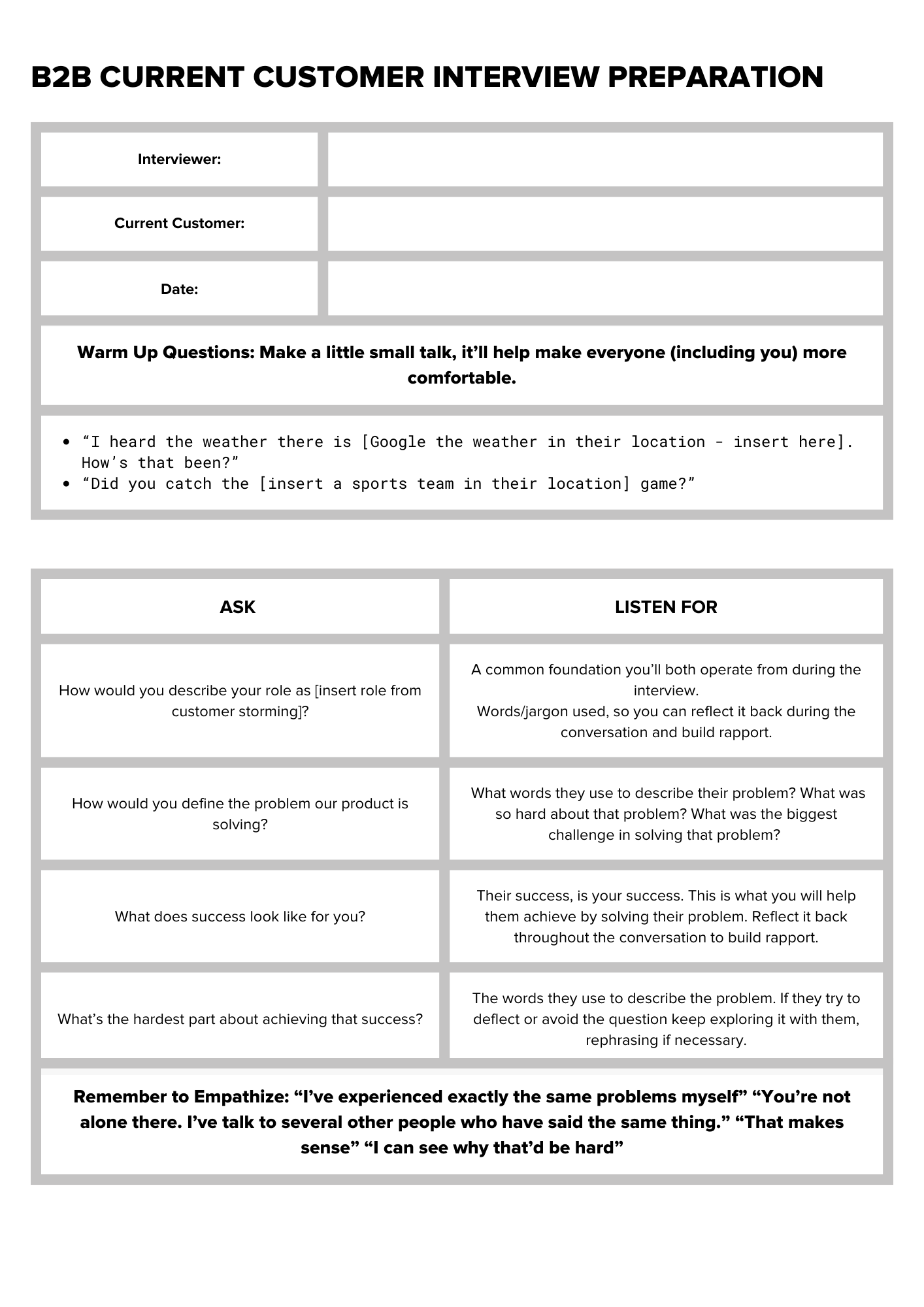

Pro tip: Record the interview, if possible. Knowing the right emotions and exact words will make it super easy not only to build your first messaging but also to seem expert in this field when on sales calls – which will help you close more sales.
Pro tip: You might have heard that 93% of communication is non-verbal and only 7% is through words. Given the criticality of these interviews to deeply understand your customers and how they see the value of your product, I highly advise conducting these interviews face-to-face or at least via video call.
After the interview, adjust your hypothesis about your ICP. Then, based on the main insights from your conversations, create the corresponding UVP and USP. You can use the template below.

Step 5 – Finalize your UVP and USP, then reformat for channels.
By now, you should have:
- One ICP you want to focus on right now.
- Validated UVP for that ICP.
- Validated USP for that ICP.
- Words, language, and tone (formal/informal/abstract/concrete/etc.) of the decision makers from the interviews you took.
- Testimonials from current customers.
Using the above, you should first rewrite your UVP and USP into the language of your decision-makers.
After that, you can simply use this core content to create specific messages for different channels. For example:
Website homepage. Use different versions of your UVP and USP on the homepage of your company website. You can include:
- A version of UVP – is above the fold. (I.e. the part of a webpage that’s visible without scrolling down.)
- A version of USP – is below the fold. (I.e. the part of a webpage that can’t be seen without scrolling down.)
- Testimonials from current customers – below USP.
- A more detailed version of how your solution delivers UVP and USP – below testimonials.
Cold email outreach. Tweak the components and tailor them to cold emails.
- Subject line – use a crisp version of the UVP.
- Body – describe your USP. You could also include a snapshot of client testimonials.
- Call to action – encourage a trial on your website or a quick phone call to discover a potential match.
Have a look at the four examples below to see how successful companies reformat their core UVP and USP to fit different channels – rather than simply putting links to their homepage in emails/Facebook ads. This makes the whole process of creating and testing messaging comparatively systematic, straightforward, and effective.
First up, Highspot. Take a look at their website homepage (above the fold and below the fold) and a sample cold email. Can you spot the different versions of USP and UVP they’ve used in both channels?
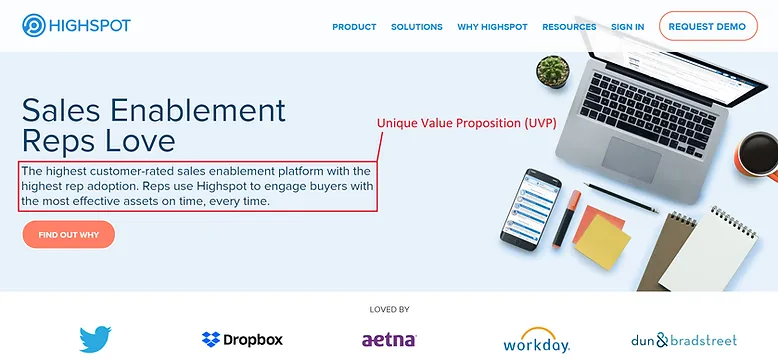
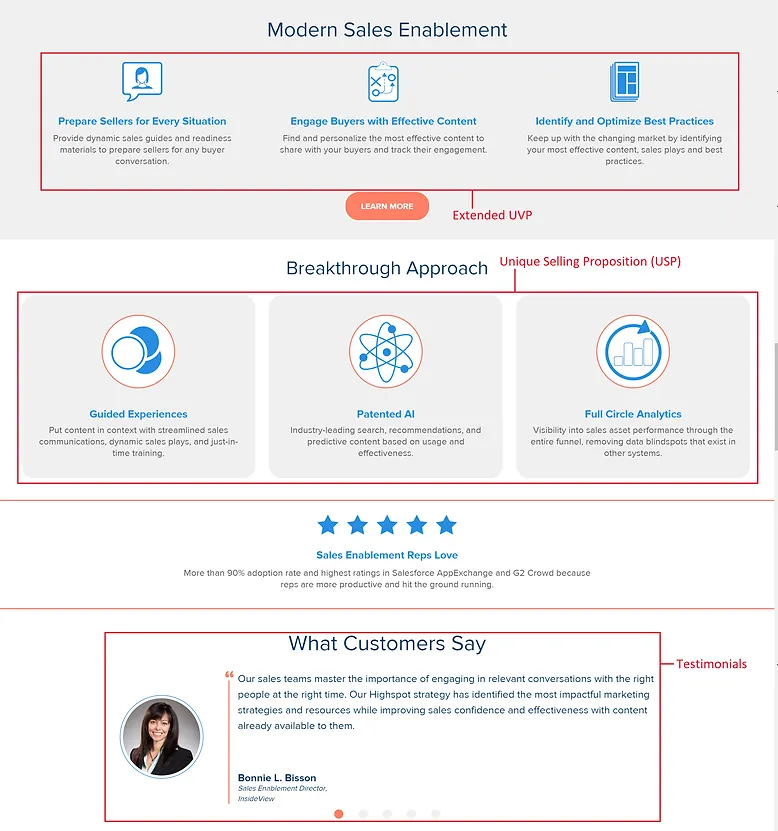
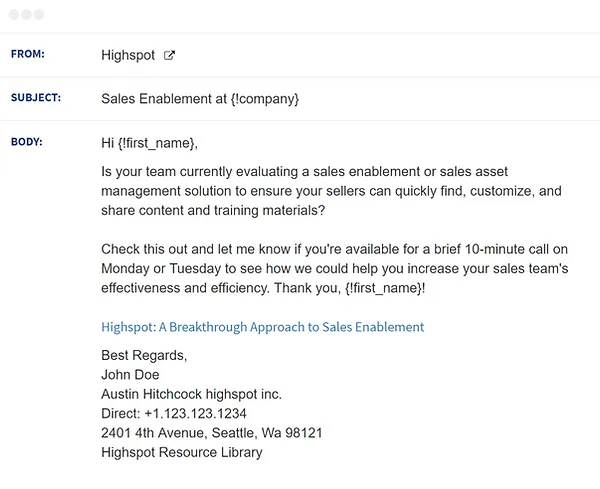
Here’s another example, from Gorgias. Look out for the reformatted versions of their USP and UVP on the homepage vs. the cold email sample.
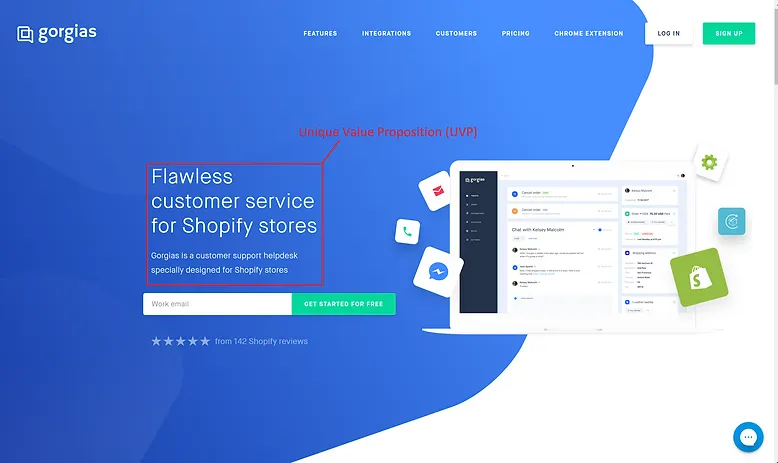
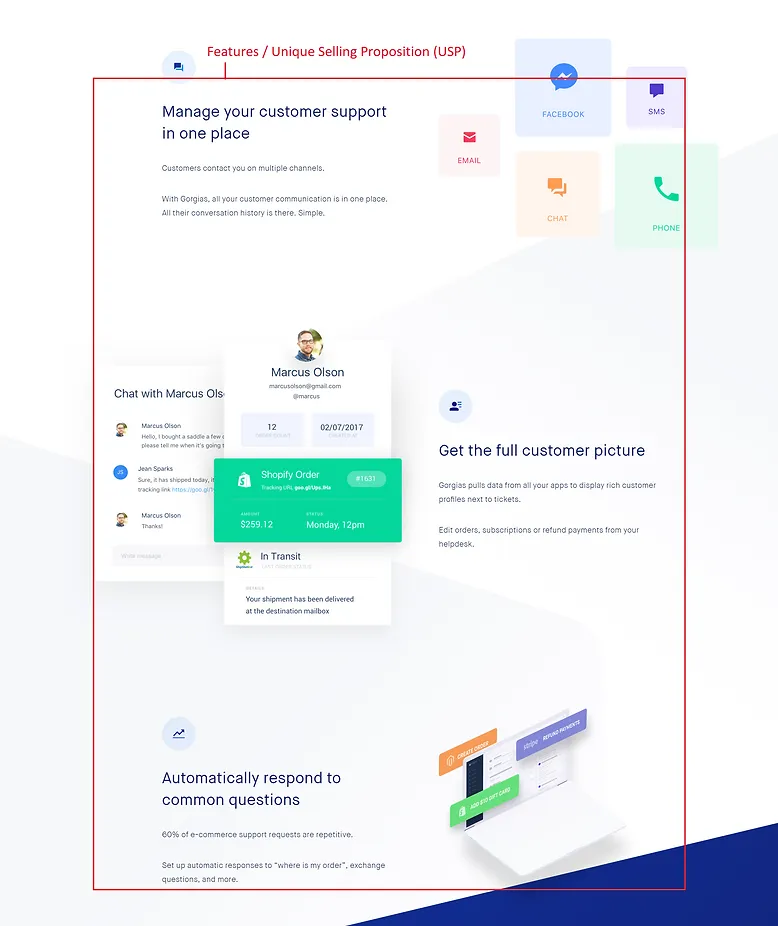
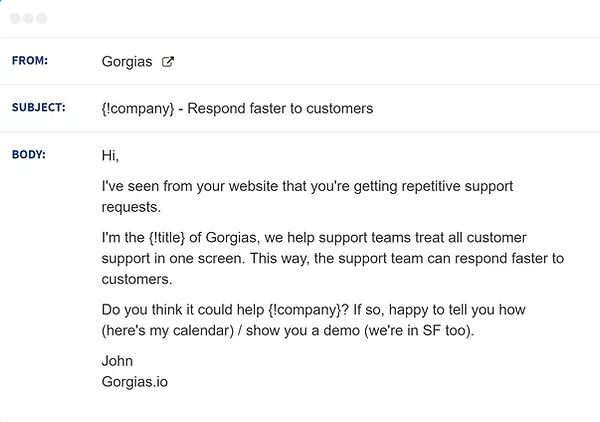
Cold call outreach. The format I provided above for emails can be easily and quickly tweaked to fit a phone call.
- Introduction – briefly explain your UVP. For example, “We do XYZ [UVP] – would you have two minutes to see if this would be interesting for you?”
- Information – elaborate on your UVP and add USP.
- Call to action – set up a 30-minute chat to discuss in more detail.
Facebook ads.
- Headline – this can be a short version of your UVP.
- Body – this can be your USP.
- Picture – this should capture your UVP or show how the user can use your product.
Take a look at the two examples of web pages and corresponding Facebook ads below. Can you see how they’ve tailored their UVP and USP to best fit the channel?
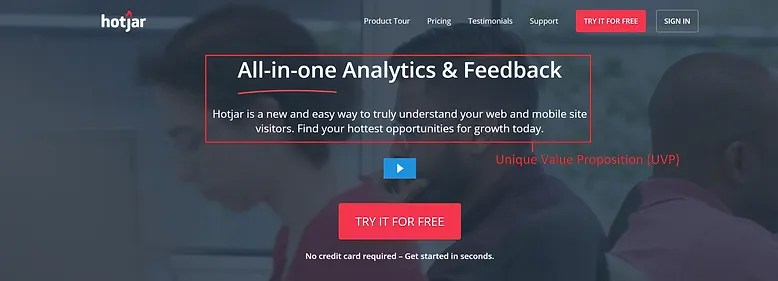
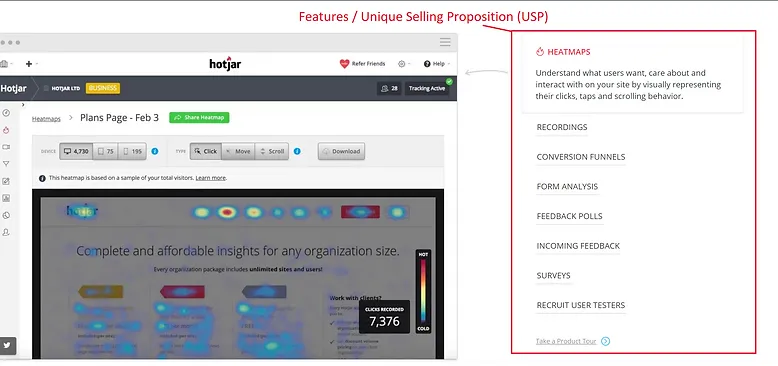
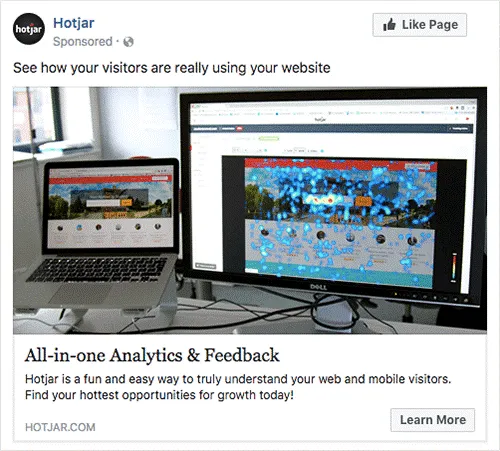
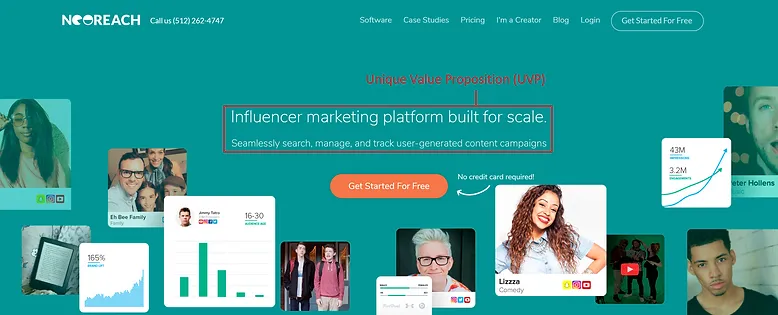
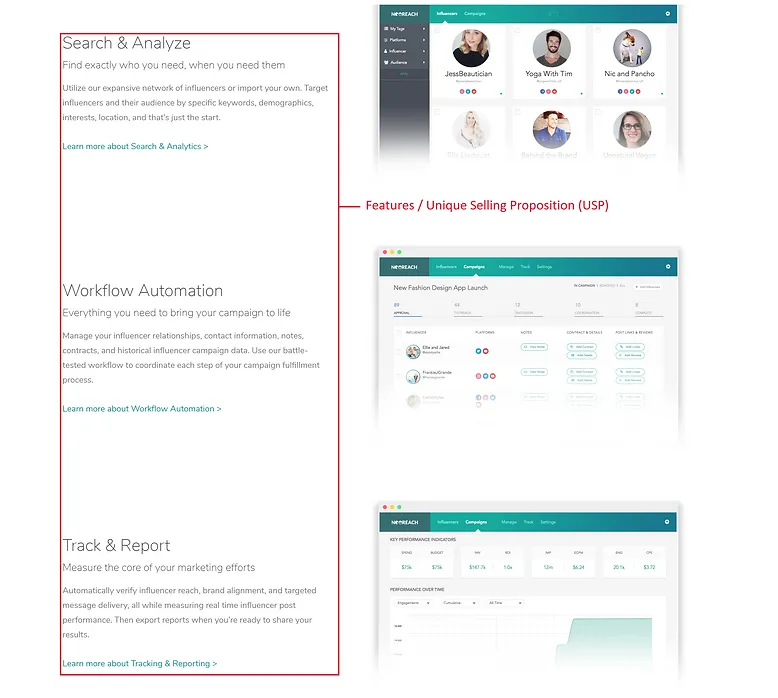
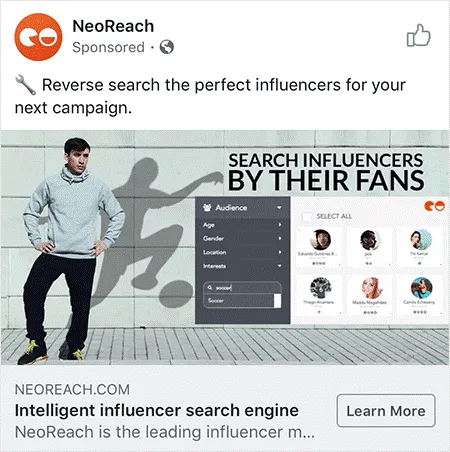
Do remember, that what you create at this stage is still the first version of your messaging.
You’ll still have to A/B test various texts and formats of these messages for different channels, to see what resonates best with your customers. By going through this process, you’ll be able to define the core of your message – which will probably remain the same unless you change your ICP or something in your product.
Here’s a great template to help you organize your message across channels – and to keep track of how it evolves over time.


Conclusion
By now, I hope you’ve got a clear understanding of how to create the perfect message for the first contact with your potential customers. The fundamental concepts I’ve explained above apply to practically all B2B startups – even though some of the minor details might be different based on your unique situation.
With the step-by-step process I’ve provided above, you’ll be able to create the best core message for your startup, which can then be reformatted to fit different channels – website, emails, phone calls, and ads on third-party platforms.








